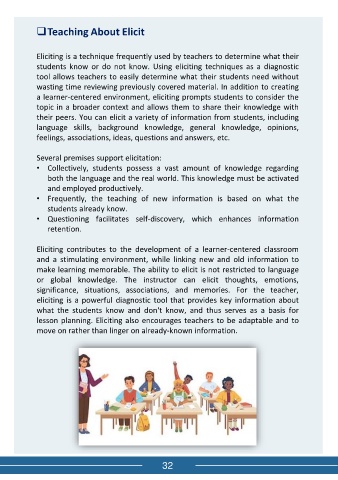Page 37 - contoh prototype_Neat
P. 37
❑Teaching About Elicit
Eliciting is a technique frequently used by teachers to determine what their
students know or do not know. Using eliciting techniques as a diagnostic
tool allows teachers to easily determine what their students need without
wasting time reviewing previously covered material. In addition to creating
a learner-centered environment, eliciting prompts students to consider the
topic in a broader context and allows them to share their knowledge with
their peers. You can elicit a variety of information from students, including
language skills, background knowledge, general knowledge, opinions,
feelings, associations, ideas, questions and answers, etc.
Several premises support elicitation:
• Collectively, students possess a vast amount of knowledge regarding
both the language and the real world. This knowledge must be activated
and employed productively.
• Frequently, the teaching of new information is based on what the
students already know.
• Questioning facilitates self-discovery, which enhances information
retention.
Eliciting contributes to the development of a learner-centered classroom
and a stimulating environment, while linking new and old information to
make learning memorable. The ability to elicit is not restricted to language
or global knowledge. The instructor can elicit thoughts, emotions,
significance, situations, associations, and memories. For the teacher,
eliciting is a powerful diagnostic tool that provides key information about
what the students know and don't know, and thus serves as a basis for
lesson planning. Eliciting also encourages teachers to be adaptable and to
move on rather than linger on already-known information.
32

